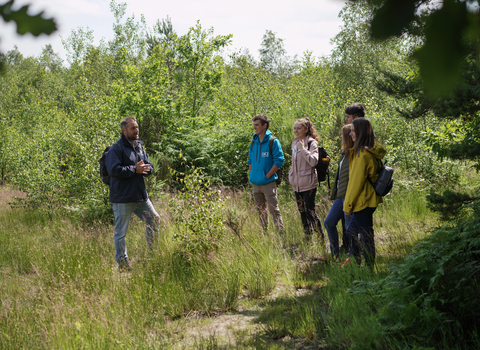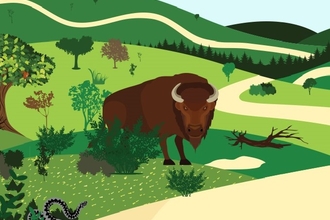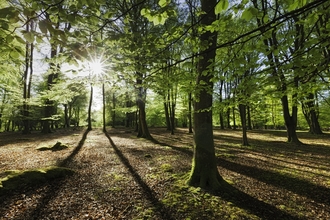What is the #WilderBlean project?
In the UK, lack of woodland management is one of the eight biggest drivers of species decline.
Thanks to funds raised by players of People’s Postcode Lottery, Kent Wildlife Trust and Wildwood Trust have partnered up to show how European bison can provide a sustainable solution to woodland management in south east England.
Similar projects across Europe have proved that bison, known as ‘ecosystem engineers’, can restore the natural biodiversity of a landscape. Natural bison behaviours - grazing, dust bathing, eating bark and felling trees - enable other species to thrive.
The presence of bison at the Blean will transform the woods into a lush, thriving, biodiverse environment once more and allow us to step back from hands-on management.
Visit our FAQ page to discover more about this incredible project and how our ecosystem engineers will help to manage this habitat and how you can get involved too.
A key part of this project will be extensive consultation and engagement with local landowners, interest groups and residents who know and love this area. Read on below and sign-up to find out more about this project and hear the latest news and updates about the impact our ecosystem engineers are having on their habitat.
Subscribe to the Wilder Blean Newsletter
Watch the moment that three bison took their first steps into the Blean here:

Planning approved for bison bridges
We are now in a position to move forward to build the bison bridges after receiving approval on our plans from Canterbury City Council and, if you share in our aspirations, you can help us build the bridges by donating to the Wilder Blean Project or by sponsoring all or part of our bridges.

Pigs, ponies and cattle join the Wilder Blean bison herd
The Wilder Blean Project has reached another milestone as ponies, pigs and cattle were released into the woodland.
Visitors may now catch a glimpse of the Exmoor ponies, Iron-Age pigs and Long-Horn cattle as they walk the footpaths through the woodland.

The bull completes the herd
We now have a heard of five free-roaming bison in West Blean and Thornden Woods after the bull, from Germany, finally made it to Kent.
You can read all about the release here.

Donovan Wright
Surprise bison calf delights rangers
Bison rangers were delighted to discover that one of the younger females had given birth to a beautiful calf. She is the first free-roaming bison calf born in the UK in thousands of years.
Read all about it here.
Why did we embark on this project?
In the UK, we’re headed for increasing species extinctions in the next 10 years.
At Kent Wildlife Trust, we know that the key to enabling species to survive and thrive is to create a nature recovery network, of bigger, better quality, and more joined up habitats
Species in the UK are declining at their fastest rate for thousands of years according to the latest State of Nature report and unfortunately, human management alone is not enough to create the kinds of habitats species need.
What we need are natural solutions and this is why we’ve taken the strategy one step further, by promoting ‘Wilding’ across some of our sites in Kent. Wilding is when nature is given the tools and space it needs to recover itself and has the potential to increase the abundance of biodiversity to levels beyond what human management achieves and helps store carbon.
How will we measure its success?
In order to demonstrate the incredible potential of wilding as a nature-based solution to the climate and nature crises, it is crucial that we monitor each project site very carefully.
Our fantastic conservation evidence team and volunteers are out on site all the time conducting extensive fieldwork and analysing data on almost everything on site, including soil health, insect and animal abundance, vegetation structure and natural processes.
Where is it?
The home of the project is West Blean and Thornden Woods nature reserve, one of the largest areas of ancient woodland in the UK.
The wood is ever-changing and has an ancient droveway through it that is almost a thousand years old. Before Kent Wildlife Trust bought the wood, it was managed commercially for timber production, which is why almost half of the wood is covered in plantations of non-native conifer trees.
What you need to know when going to Blean

Credit: Amanda Fegan
What can you do to help?
By supporting this project, you are helping to create a bigger, better, more biodiverse home for wildlife in Kent.
Our next step is to ensure the bison can roam through their areas of the Blean, utilizing their natural behaviours and promoting landscape connectivity, whilst keeping the Blean open for the public to enjoy.
Talk to us about sponsorship opportunities for your business
And there are many more ways you can help us to create a #WilderKent…
The Wilder Blean project aims to create a template for future wilding projects nationally. It is undeniably important that we take this leap of faith to heal nature and looking forward to a wilder future. Support Kent Wildlife Trust and help us to fight the climate and biodiversity crises for you, your children and your children’s children.















